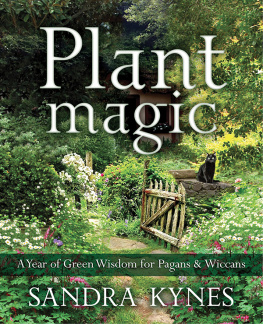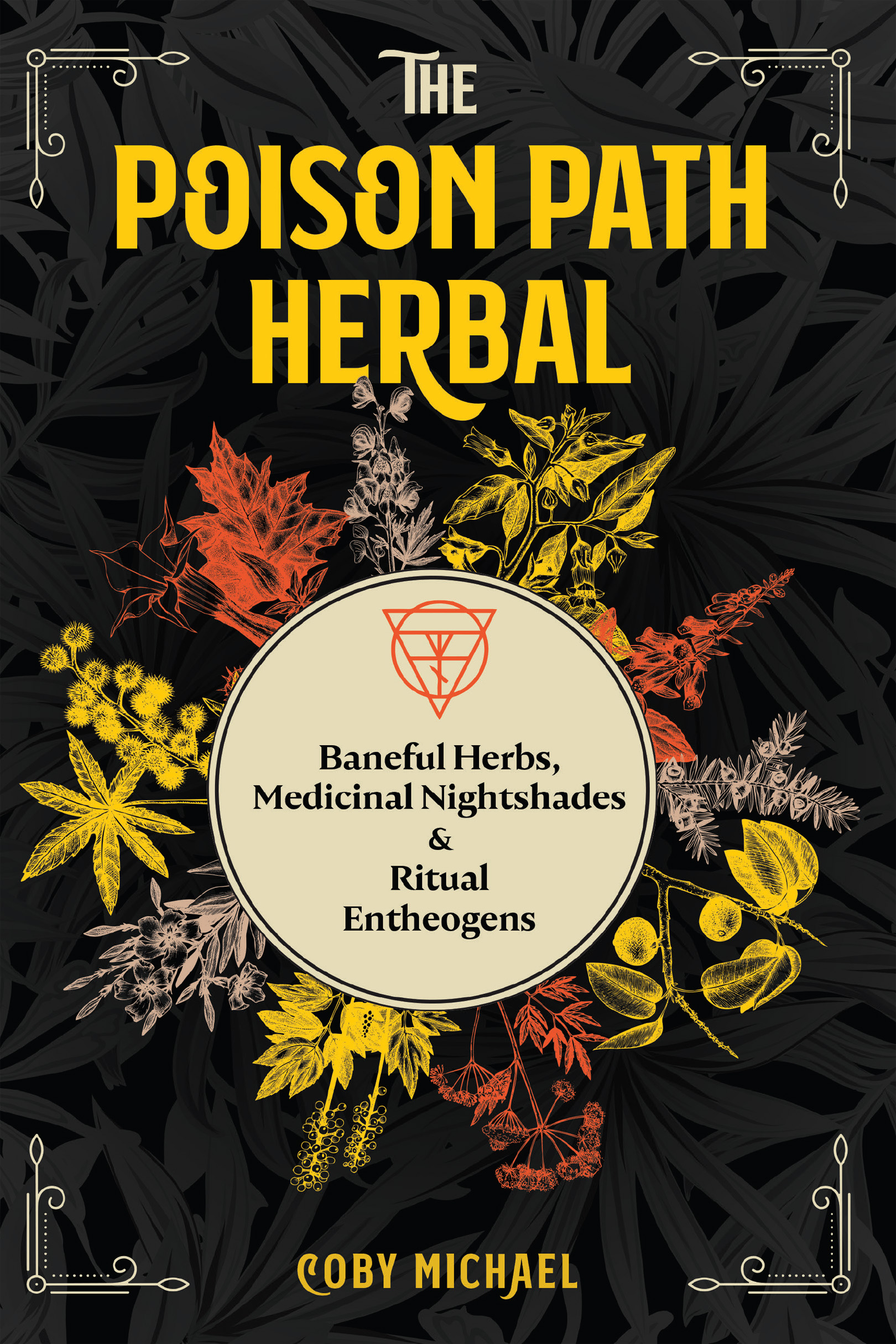
To my grandparents,
for showing me the beauty and magic
of the natural world
THE
POISON PATH HERBAL

Coby Michaels The Poison Path Herbal is THE book that witches on the Poison Path have long been waiting for. It is an intense ride through the history and folklore of baneful plants, with exceedingly clear instructions on how to not only successfully grow them in your own garden but it also thoroughly details their proper preparation and usage on both magical and mundane levels. This is truly an important addition to the library of any apothecary or hedge rider.
TARA-LOVE MAGUIRE, COAUTHOR OF BESOM, STANG, AND SWORD
Reading The Poison Path Herbal is like sitting around a fire on a moonlit midsummer night conversing with a master of occult secrets. Brilliantly discussing Renaissance magic and herbalism; Greek, Roman, Egyptian, and Norse mythology; Biblical lore; and modern understandings of plant medicines; Michael seamlessly laces botanical science with entheogenic enchantment throughout this engaging work. In the process he outlines the Poison Path, showing the various mysteries and divine associations of Venus, Saturn, and Mercury. Read closely and carefully, as this book is not for the faint of heart. Michael is a real witch, and this is a book of real witchcraft, which includes recipes to make your own psychoactive tinctures, incense, beer, tea, and ointments. Hellhe even teaches you how to grow the magical plants yourself! The Psychedelic Renaissance has been waiting for a book like thisan advanced entheogenic grimoire for the witchy, the wyld, and the wyrd.
THOMAS HATSIS, AUTHOR OF THE WITCHES OINTMENT
Coby exquisitely, with much research and deep respect, presents venefic, malefic, cthonic, and pure Poison Path magic, ethnobotany, and history at its finest. This is an essential book for any serious poisoner and herbalist.
JACLYN CHERIE, OWNER OF THE NEPHILIM RISING
Coby beautifully combines history, folklore, science, and magic in The Poison Path Herbal with a compelling and charismatic writing style, drawing on years of practice and experience. It is an informative and poetic resourcea powerful introduction to the Poison Path, and a reference for more advanced students.
IAN VERTEL, FOUNDER AND OWNER OF POISON PLANT CULT
Danger! Toxic!

Many of the plants discussed within this book are poisonous. If used improperly, they can cause illness and even death. It is important when working with baneful herbs that you take extra precautions, such as wearing gloves and protective eye coverings, using tools designated for poisonous plants, and clearly labeling any dangerous formulas to protect yourself and others. The information in this book can be dangerous in the wrong hands! Please do not use this information to poison an unsuspecting partner or launch any other diabolical schemes. All of the details in this book are for informational purposes only and are not meant to diagnose, prescribe treatment, or go against the advice of your physician. When implementing any of the information or techniques described here, you are doing so at your own risk. Consult with your physician before experimenting with new plants, especially if you are taking any medication, and avoid them if you have a heart condition or are pregnant. There are many safe and powerful ways to work with these plants without consuming them. Neither the author nor the publisher is responsible for any adverse effects that come from using the information in this book.
Introduction
T he Poison Path, as it has become known, is a branch of occult herbalism combined with entheogenic ritual practice, phytochemistry, and magic. The Poison Path is not limited to traditions of witchcraft or paganism. Although it is inherently animistic, there are no dogmas or institutions that restrict the use of this knowledge.
The Poison Path Herbal is focused on the magical and spiritual uses of baneful herbs, entheogens, and plant spirit allies, as well as their history and mythology. I personally came to know the uses of these plants through the practice of witchcraft and folk herbalism. It is through this lens that I have gained my own personal gnosis in regard to the intimate connections that some of these plants share with the practice of witchcraft and the ancient cultures that preceded Christianity.
Baneful refers to the ability of a thing to cause harm, and because of this threat, the baneful thing becomes taboo and gains a sinister reputation. In this case, we are talking about baneful herbs: herbs capable of causing bodily harm and sometimes death. They are plants that have been used for murder, execution, magic, and medicine throughout human history. Their prominent and often maligned place in the human pharmacopoeia is owing to their potency. Baneful herbs make powerful medicines and are often valued for their pain-relieving and sleep-inducing properties. Many of the plants in this category have a profound effect on human perception.
Entheogens are substances with the ability to generate spiritual experiences and altered consciousness within an individual or group. As with any mind-altering substance, the atmosphere and intention are a major influence on the experience. Entheogens are known for their ability to open us up to the spirit world through altering consciousness in order to work magic, prophesy, and commune with spirits. Through ritual and reverence, we are able to access the entheogenic effects of these plants. By changing human perception in subtle or extreme ways, they give us access to the divine, the otherworldly, and the arcane. While there are many substances that make up the entheogenic pharmacopoeia, they are not always used for spiritual purposes. Some substances, such as cocaine, tobacco, and caffeine, are predominantly consumed for recreational use. However, their entheogenic applications are not without merit.
Many entheogenic plants, such as belladonna, poppy, and datura, are also known for their baneful nature. They are powerful botanicals that if taken improperly could cause death. In addition to their poisonous properties, baneful herbs have a naturally dark and dangerous quality about them. Plants with thorns, carnivorous plants, and plants that grow around places we associate with the dead are all known for their baneful or baleful natures. Baneful herbs with entheogenic properties are also powerfully medicinal when one has the knowledge of how to use them. They have been used for centuries by virtually every human civilization for their medicinal and spiritual properties.
The Poison Path is a spiritually based practice that explores the esoteric properties of potentially deadly plants, and while many of them have entheogenic qualities, it was their poisonous nature that first attracted me. While the study of ritual entheogens can keep one busy for decades, we should not assume that they are the only way of accessing certain states of consciousness. It is a subcategory or supplemental set of tools and knowledge that can be utilized to enhance ones spiritual tradition. Many techniques exist for entering trance, altering perceptions, and encouraging spiritual experiences that do not require the use of mind-altering substances. These plants are not deities, and an entire tradition is not built up around them. The plants that belong to the Poison Path are among many guides and allies that we will meet along the way. Their entheogenic properties are the physical manifestation of the teaching powers that the spirits of these plants possess. Each plant spirit has an individual and complex personality.









